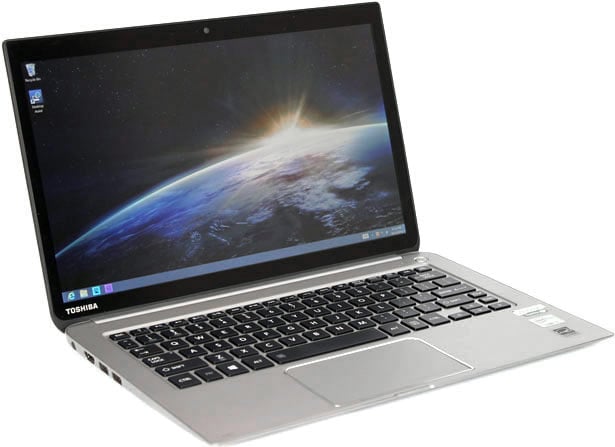Toshiba KIRAbook High Resolution Ultrabook
Introduction & Specifications
With the KIRAbook 13 I7, Toshiba is flexing its muscles and taking on the likes of Apple, Asus, and Lenovo in the ultrabook arena. And you know what? Toshiba seems to be on the right track. With clean lines, a 2560 x 1440 resolution display and a slick magnesium alloy body, the KIRAbook is anything but a typical laptop.
Hitting a home run in this market isn’t easy, because a true ultrabook should be as much about form as it is function. It should be thinner than a laptop, and lighter too. It needs processing power as well as decent battery life. But small, powerful hardware usually comes at a steep price, and driving the price too high invites unfavorable comparisons to other solutions. Ultrabook dimensions demand compromises, but consumers aren’t typically willing to make any one prices creep to high. What would you sacrifice? Not speed, of course. Great speakers? Not if you watch video without earphones. Graphics? Not very likely unless you don't game much. Storage space? Maybe, depending on how you feel about leveraging the cloud. Keyboard quality? Weight and size? Trackpad quality? Display quality? These are all areas where a certain level of compromise can be acceptable in a laptop, so long as the system is strong contender for it's particular target audience and use case. Ultrabooks, on the other hand, are expected to approach perfection. And (unlike more than a few ultrabooks) the Toshiba KIRAbook almost does.
|
| Operating System: | Windows 8 Pro 64-bit |
| Processor: | Intel Core i7-3537U Dual-Core (2.0GHz, TurboBoost to 3.1GHz) |
| Chipset: | Intel Ivy Bridge/HM76 |
| Graphics: | Intel HD Graphics 4000 |
| Memory: | 8GB DDR3-1600 (PC3-12800) |
| Storage: | 256GB mSATA SSD Toshiba THNSNF256GMCS |
| Display: | 13.3-inch PixelPure Backlit LED at 2560 x 1440 (16:9 Aspect Ratio), 10-Point Touchscreen |
| Webcam: | Toshiba HD Webcam |
| Sound: | Dual Microphones with Beam Forming Technology, DTS Studio Sound, Harman/Kardan Speakers |
| Interface: | 3 x USB 3.0 ports, one of which supports USB Sleep and Charge, HDMI, SD Card Reader, Mic/Headphone Jack |
| Networking: | Intel Centrino Wireless-N 2230 802.11b/g/n with Wi-Di, Bluetooth 4.0 |
| Backlit Keyboard: | Yes |
| Battery: | 4-Cell Li-Ion 52Wh (Not User-Replaceable) |
| Power Adapter: | 45W AC Adapter |
| Dimensions: | 12.44 x 8.15 x 0.7 (WxDxH) |
| Weight: | 2.97 pounds |
| Enclosure: | AZ91 Magnesium Alloy Case |
| Warranty: | 2-Year Limited (1-Year Battery) |
| Software: | Adobe Photoshop Elements 11 & Premiere Elements 11 (full), DTS Studio Sound, Symantec Norton Internet Security, Norton Online Backup, Norton Anti-Theft (24-month subscriptions to all three Norton products), Toshiba Recovery Disk Creator, Video Player, Eco Utility, and Resolution+ Upconvert Plug-In for Media Player |
| Price: | $1999.99 on Amazon |
It's high-DPI better-than-HD display is getting the KiRAbook a lot of attention, but let’s start with the KIRAbook’s guts and work our way out. Understandably, this ultrabook doesn’t pack a Haswell CPU, which is Intel’s new 4th-generation processor. The new, high performance/low power consumption CPU arrived shortly after the launch of the KIRAbook. But the processor in the KIRAbook we reviewed – an Intel Core i7-3537U -- launched in the first quarter of the year and remains a very respectable choice. We do expect Toshiba to roll out a Haswell update here but it's hard to say just when. The machine's dual-core Ivy Bridge processor has a 2.0GHz base clock speed with Turbo Boost to 3.1GHz. We reviewed the Core i7 version of the KIRAbook; the other two models have Core i5-3337U processors ($1,799.99 with a touchscreen, $1,599.99 without one).
The KIRAbook backs up the processor with 8GB of DDR3-1600 memory (two 4GB DIMMs) and integrated Intel HD Graphics 4000, which is standard fare on notebooks that don’t have discrete graphics. That’s a solid CPU/MEM/GFX lineup, and it’s bolstered by the speed of the KIRAbook’s 256GB mSATA SSD. Whether you’re comfortable with 256GB as your system’s total storage depends a lot on how much data you use and where you store it. Our review system had a little over 200GB of available storage on arrival, which is probably enough for most people.
One feature you might miss is an Ethernet port. The KIRAbook relies solely on wireless connectivity. That’s not too surprising, given the system’s thin body, but business users who like to plug in for a rock-solid connection won’t have that option. Wi-Fi is handled by Intel’s Centrino Wireless-N 2230 controller. The system also supports Intel Wireless Display (WiDi), which lets you wirelessly display content on your HDTV. The laptop also has Bluetooth 4.0.
Toshiba gave the KIRAbook serious audio chops as well. For recording audio, you have dual, beam-forming microphones. For output, you’re looking at Harman/Kardan speakers, powered by DTS Studio Sound. The result is that the volume can easily overcome typical office and home noises when you’re watching TV or listening to music.
And that volume is important because the KIRAbook’s fan can get quite loud when it kicks into high gear – as it did whenever we fired up movies on Netflix or ran benchmark software. When the system is handling Web surfing or other tasks, it’s silent, but when the laptop is under load, the fan emits both a loud wind noise and a high-pitched whine. The noise isn’t a showstopper, but it’s distracting.









